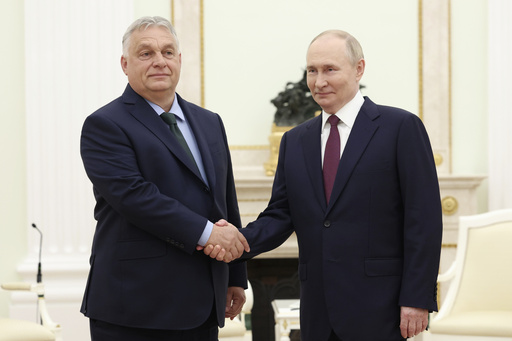
BUDAPEST, Hungary — Just moments before President Donald Trump was inaugurated for his second term, he hinted at a forthcoming “golden age” for America. Echoing these sentiments, Hungarian Prime Minister Viktor Orbán projected that Trump’s return would herald a similar “golden age” for Hungary while signifying the decline of liberal democracy. This parallel messaging between the two leaders did not come as a surprise.
Orbán has emerged as a prominent figure for U.S. conservatives seeking inspiration in Hungary’s governance model, which advocates for reduced immigration, decreased regulatory measures, and the dismantling of what they perceive as cumbersome democratic protocols. The relationship between Trump and Orbán has blossomed over the years, with Orbán frequently visiting Trump’s retreat in Florida. Recently, Orbán lauded Trump’s direct communications with Russian President Vladimir Putin regarding the ongoing conflict in Ukraine. During a previous U.S. presidential debate, Trump described Orbán as a “strong man” and “a tough person.”
Since returning to power on January 20, Trump has been pushing the boundaries of presidential authority, prompting comparisons to the anti-democratic tactics utilized by Orbán and other authoritarian leaders. Orbán has employed state apparatus to suppress opposition, transform the judiciary, and engineer electoral processes that make it increasingly difficult for rival parties to challenge his dominance. His administration has also targeted LGBTQ+ rights, limited immigration, and imposed restrictions on the media and civic organizations.
Despite differences in their respective political frameworks and methods, there are striking similarities in the paths Orbán has taken in Hungary and the direction Trump is pursuing in his second term.
After initially becoming Prime Minister in 1998, Orbán faced an unexpected setback four years later, vowing never to experience defeat again. In response, he and his supporters began crafting a robust legal infrastructure to centralize power, which was promptly enacted after Orbán’s Fidesz party clinched a supermajority in the 2010 elections. While this strategy was not explicitly labeled as “Project 2025,” it serves a similar purpose to the conservative blueprint outlined for Trump’s second term, as noted by observers. The European Parliament has categorized Hungary under Orbán as an “electoral autocracy.”
Upon assuming office with a GOP-majority Congress, Trump swiftly unleashed a barrage of executive actions aimed at amplifying the powers of the presidency and testing the viability of the nation’s checks and balances. He has continued to implement policy changes without congressional input. The American Bar Association has raised alarm, asserting that much of Trump’s agenda contravenes the rule of law.
One of Fidesz’s most significant early initiatives involved undermining the independence of the judiciary. In 2012, the government reduced the retirement age for judges, resulting in the dismissal of almost 300 senior judicial figures, with appointments falling under the purview of a politically connected individual. This strategy effectively allowed Orbán to manipulate the judiciary to his advantage.
Although the Trump administration cannot unilaterally reshape the entire judiciary, Republican efforts have long aimed at establishing a conservative judiciary. In his first term, Trump appointed three justices to the U.S. Supreme Court, securing a conservative supermajority that recently protected him from legal repercussions related to his actions surrounding the 2020 election. He has sought to reshape the U.S. Department of Justice after openly expressing intentions to target detractors and those involved in investigations against him.
Trump’s administration has taken a combative stance towards judges who opposed its policies, even hinting at the possibility of ignoring unfriendly rulings. Yet, the influence Trump wields over the judiciary is not absolute, as many judges he appointed showed independence when rejecting his attempts to overturn the previous election results.
Following his return to power, Orbán promptly began to reform Hungary’s constitution and election procedures, solidifying his party’s legislative dominance. This manipulation enabled his party to secure a two-thirds majority in every election since 2010, despite sometimes receiving less than half of the votes. The candidate selection process in Hungary, whereby parties select their own nominees for parliament, grants Orbán unyielding authority in political appointments.
“His will dictates who can take part in politics,” remarked Zsuzsanna Szelényi, a former Fidesz member who departed the party in 1994. Orbán has positioned his party as a custodian of true Hungarian identity, denouncing opposition members as unpatriotic and aligned with foreign interests. This strategy mirrors Trump’s own rhetoric toward his rivals.
Orbán’s systematic erosion of independent media, through benefitting allies acquiring key outlets, parallels Trump’s ongoing pressure on American media via litigation and regulatory threats. While Trump cannot dictate party elections with the same degree of control as Orbán, there is no denying his significant influence within the Republican Party, which has embraced loyalty to him as a core tenet.
Trump is also advocating for modifications to civil service regulations that would allow him to dismiss federal employees deemed disloyal and potentially replace them with his supporters.
The journey Orbán has taken toward autocracy coincided with his pivot towards alliances with nations such as Russia and China. Observers note that Orbán recognized the constraints of democratic governance as barriers to implementing his vision for Hungary, leading him to adopt autocratic models, particularly from Putin’s regime.
Trump’s favorable comments about authoritarian leaders throughout his career, including praising Putin’s actions, further illustrate the ideological overlap between the two leaders. Experts may believe that, unlike Hungary’s political landscape, the United States possesses fundamental differences in political and economic structures that might hinder a similar level of control. However, the swift transformations in Hungary under Orbán should act as a cautionary example.
“Once the process of autocratization commences, it tends to snowball,” she cautioned. “It’s not a mere phase—it’s a continuous progression.”

